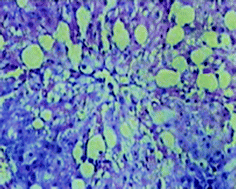A team from India has shown that an edible blue-green algae Spirulina laxissima can protect the liver against CCl4 induced oxidative damage in rats.
 Spirulina species have been used as food for thousands of years and many medicinal properties have been attributed to them such as weight and cholesterol reduction and radical-scavenging action. Spirulina is also an important source of the blue photosynthetic pigment phycocyanin (PC), which has been described as a strong antioxidant and anti-inflammatory natural compound. Carbon tetrachloride (CCl4) is a well-known hepatotoxic agent. The changes associated with CCl4-induced liver damage are similar to those of acute viral hepatitis and CCl4-induced liver damage is a classic model used for the screening of hepatoprotective drugs.
Spirulina species have been used as food for thousands of years and many medicinal properties have been attributed to them such as weight and cholesterol reduction and radical-scavenging action. Spirulina is also an important source of the blue photosynthetic pigment phycocyanin (PC), which has been described as a strong antioxidant and anti-inflammatory natural compound. Carbon tetrachloride (CCl4) is a well-known hepatotoxic agent. The changes associated with CCl4-induced liver damage are similar to those of acute viral hepatitis and CCl4-induced liver damage is a classic model used for the screening of hepatoprotective drugs.
The ethanol extract of Spirulina laxissima (EESL) was used in experiments as it was demonstrated to have the greatest antioxidant properties compared to methanol and water extracts. In this study EESL was dosed an hour before CCl4 and the treatments were administered to rats 3 times a week for 5 weeks. A variety of markers were used to assess liver function after this period; protein and antioxidant levels in the liver as well as liver function marker enzymes. Treatment with CCl4 resulted in liver damage in all parameters tested, but treatment with EESL before CCL4 treatment reduced the hepatotoxic effects of CCl4.
This study, by Gini C. Kuriakose and Muraleedhara G. Kurup, demonstrates the hepatoprotective and antioxidant properties of the ethanol extract of S. laxissima (EESL). The authors suggest that the hepatoprotective effect of EESL may be due to the presence of phycocyanin pigment however further studies are needed to identify and isolate the active principles of EESL.
Interested in knowing more? Read the full article here!
Antioxidant and antihepatotoxic effect of Spirulina laxissima against carbon tetrachloride induced hepatotoxicity in rats
Gini C. Kuriakose and Muraleedhara G. Kurup
Food Funct., 2011, Advance Article
DOI: 10.1039/C0FO00163E
All articles in Food & Function are free for the duration of 2011!










